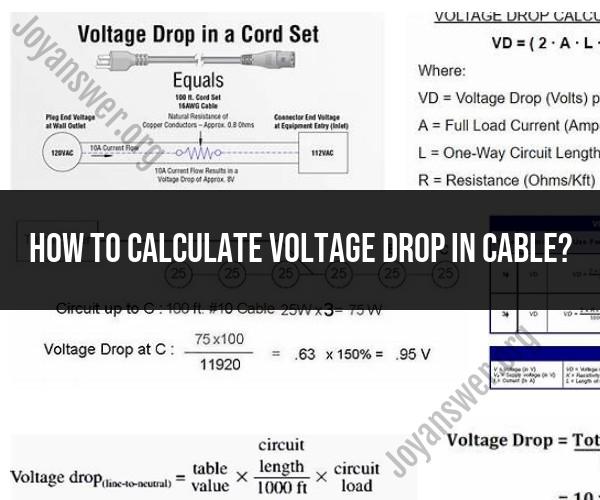How to calculate voltage drop in cable?
Voltage drop in a cable occurs when there is a loss of voltage as electrical current flows through the cable due to its resistance. To calculate voltage drop in a cable, you can use the following formula:
Voltage Drop (VD) = I x R x L
Where:
- VD is the voltage drop in volts (V).
- I is the current in amperes (A) flowing through the cable.
- R is the resistance of the cable in ohms per unit length (typically ohms per meter or ohms per 1000 feet).
- L is the length of the cable in meters (m) or feet (ft).
Here's a step-by-step guide on how to calculate voltage drop in a cable:
Determine the Current (I): First, determine the current (in amperes) that will be flowing through the cable. This could be the current of the electrical load or device connected to the cable.
Find the Cable's Resistance (R): The resistance of the cable depends on its material, size, and temperature. You can usually find this information in the cable manufacturer's specifications. The cable's resistance is typically given in ohms per unit length (e.g., ohms per meter or ohms per 1000 feet). If it's not provided, you may need to calculate it using the cable's material properties and cross-sectional area.
Measure the Cable Length (L): Measure the length of the cable over which you want to calculate the voltage drop. Make sure to use consistent units (meters or feet) throughout the calculation.
Apply the Formula: Plug the values you've determined into the formula: VD = I x R x L.
Calculate the Voltage Drop: Multiply the current (I), cable resistance (R), and cable length (L) together to calculate the voltage drop (VD) in volts.
Interpret the Result: The calculated voltage drop represents the amount of voltage that will be lost as the current flows through the cable. It's essential to compare this voltage drop to the voltage available at the source and ensure that it does not exceed acceptable limits. In many electrical systems, there are specific voltage drop limits that must be adhered to, especially in critical applications.
Keep in mind that minimizing voltage drop is crucial in electrical installations to ensure that the connected devices receive the required voltage for proper operation. Using cables with lower resistance (larger cross-sectional area) or increasing the voltage supply can help reduce voltage drop in a circuit. Additionally, consult relevant electrical codes and standards for guidance on acceptable voltage drop limits in your specific application.
Calculating Voltage Drop in Cables: Methods and Formulas
There are two main methods for calculating voltage drop in cables:
- The Ohm's law method: This method uses Ohm's law to calculate the voltage drop across a cable. Ohm's law states that voltage is equal to current times resistance. Therefore, the voltage drop across a cable can be calculated by multiplying the current flowing through the cable by the resistance of the cable.
- The cable voltage drop tables: Cable voltage drop tables are tables that show the voltage drop for different cable sizes, cable lengths, and currents. These tables can be used to quickly and easily estimate the voltage drop across a cable.
The following formula can be used to calculate voltage drop in cables using the Ohm's law method:
Voltage drop = Current × Resistance
Where:
- Voltage drop is in volts (V)
- Current is in amperes (A)
- Resistance is in ohms (Ω)
To calculate the voltage drop in cables using the cable voltage drop tables, simply look up the voltage drop for the cable size, cable length, and current that you are interested in.
Cable Voltage Drop Analysis: A Practical Guide
When performing a cable voltage drop analysis, there are a few things to keep in mind:
- The type of cable: Different types of cables have different resistances. For example, copper cables have lower resistances than aluminum cables.
- The cable size: The larger the cable size, the lower the resistance.
- The cable length: The longer the cable, the higher the resistance.
- The current flowing through the cable: The higher the current, the higher the voltage drop.
Once you have considered all of these factors, you can use the Ohm's law method or the cable voltage drop tables to calculate the voltage drop across the cable.
Ensuring Efficiency: How to Compute Voltage Drop in Cables
Computing voltage drop in cables is important for ensuring the efficiency of electrical systems. By calculating the voltage drop across a cable, you can determine the amount of voltage that is lost due to the resistance of the cable. This information can then be used to select the correct cable size for the application and to ensure that the electrical system operates efficiently.
Here are some tips for ensuring efficiency when computing voltage drop in cables:
- Use the correct cable size for the application.
- Keep the cable length as short as possible.
- Use copper cables instead of aluminum cables, if possible.
- Consider using multiple cables instead of a single large cable.
- Use cable voltage drop tables to quickly and easily estimate the voltage drop across a cable.
By following these tips, you can ensure that you are computing voltage drop in cables accurately and efficiently.











